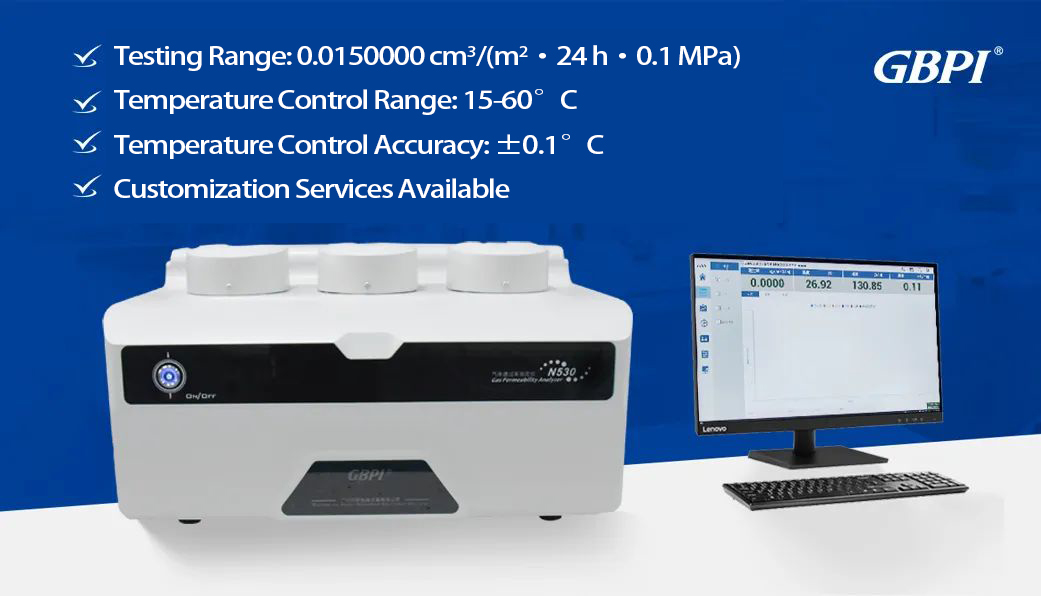Proton Exchange Membrane Fuel Cells (PEMFCs) utilize renewable energy sources—hydrogen—to achieve zero emissions, making them a green, clean, efficient, and sustainable new energy technology. They have wide applications in industries such as aerospace, automotive, and energy. The Proton Exchange Membrane (PEM) is one of the most crucial components of a PEMFC. With the continuous development of fuel cells, the performance requirements for PEMs have been gradually increasing. According to GB/T 20042.3-2022 "Proton Exchange Membrane Fuel Cells - Part 3: Test Methods for Proton Exchange Membranes," the required tests for PEMs include permeability, tensile properties, 180° peel strength, thickness, proton conductivity, and ion exchange capacity. This article focuses on the permeability testing of fuel cell proton exchange membranes, introducing the testing methods and related equipment.
Introduction: Proton Exchange Membrane Fuel Cells (PEMFCs) are power generation devices that convert the chemical energy of hydrogen and oxygen directly into electrical energy without combustion, essentially functioning as the "reverse" of water electrolysis. A single cell consists of an anode, a cathode, and a proton exchange membrane. The anode is where the hydrogen fuel undergoes oxidation, while the cathode is where the oxidant is reduced. Both electrodes contain catalysts that accelerate the electrochemical reactions. The function of the proton exchange membrane is to conduct protons (H⁺) while separating the fuel at the anode from the oxidant at the cathode. The polymer structure of the proton exchange membrane contains various ionic groups, allowing only hydrogen ions (H⁺) to pass through, while blocking other ions, gases, and liquids. PEMFCs are characterized by high energy conversion efficiency, pollution-free power generation, simple structure, easy maintenance, and no pollution.
Proton Exchange Membrane Permeability Testing Method: The permeability is defined as the volume of gas that passes through a unit area of the sample per unit time under a constant temperature and unit pressure difference, primarily used to assess the gas permeation performance in the proton exchange membrane. Strictly limiting the upper threshold of the proton exchange membrane's permeability is crucial to prevent excessive leakage through small perforations, thereby ensuring safety against thermal runaway risks. The GB/T 20042.3-2022 standard specifies the use of the differential pressure method for testing the permeability of proton exchange membranes. The differential pressure method is non-selective regarding the test gas and has excellent versatility for different test gases. With advancements in detection instrument technology, the accuracy of the equipment and the repeatability of the test data are well assured.
Testing Instrument: Our N530 2.0 Gas Permeability Tester is designed and manufactured based on the differential pressure method principle. During the testing process, the prepared sample is placed between the upper and lower chambers of the instrument, separating the high-pressure chamber from the low-pressure chamber. A vacuum pump evacuates the entire gas circuit system, reducing the pressure in both the high-pressure and low-pressure chambers to below 10 Pa. Then, an experimental gas at atmospheric pressure is introduced into the upper chamber, creating a constant pressure difference between the upper and lower chambers. Under the influence of the pressure gradient, the gas permeates through the test sample from the high-pressure chamber to the low-pressure chamber. The instrument automatically calculates the gas permeability, gas transmission rate, and other barrier performance parameters of the sample by monitoring the pressure change in the lower chamber.
The N530 2.0 Gas Permeability Tester is equipped with three chambers, each with its own independent sensor and temperature control unit, supporting the simultaneous testing of three identical or different samples. Each chamber operates independently, with independent data collection. The instrument features fully automatic operation, one-click testing, automatic judgment, and automatic shutdown, ensuring high testing efficiency. It employs patented automatic pressure difference maintenance technology to automatically maintain the pressure difference across the sample (adjustable pressure difference), and is equipped with a high-precision pressure sensor with a resolution of 0.01 Pa, offering excellent stability and low failure rate. The tester uses an imported vacuum pump with an ultimate pressure of 0.1 Pa, providing high vacuum efficiency and low noise. Additionally, it features a new pneumatic gas circuit control system with automatic clamps for one-touch sample locking, ensuring convenience, labor-saving operation, and superior sealing performance.
The N530 2.0 can measure the permeability of gases such as O2, CO2, N2, and H2. Guangzhou Biaoji provides customized services to meet different customer requirements regarding test gases, pressure, temperature, and safety
Summary and Outlook: Proton exchange membrane fuel cells (PEMFCs) are power generation devices that convert the chemical energy of fuel and oxidants directly into electrical energy. The performance of their key components directly affects the stability and reliability of the fuel cells, playing a decisive role in the overall performance of the fuel cell stack. Therefore, using a differential pressure gas permeability tester to measure the permeability of proton exchange membranes is of great significance for controlling the quality of fuel cells and for the improvement and optimization of manufacturing processes.

 info@gbtest.cn
info@gbtest.cn



 en
en ru
ru es
es ar
ar
